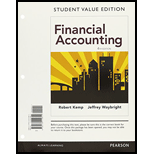
Financial Accounting, Student Value Edition Plus MyLab Accounting with Pearson eText -- Access Card Package (4th Edition)
4th Edition
ISBN: 9780134417356
Author: Robert Kemp, Jeffrey Waybright
Publisher: PEARSON
expand_more
expand_more
format_list_bulleted
Question
Chapter 4, Problem 22AE
1.
To determine
Prepare the multi-step income statement for the year ended August 31, 2016 of Incorporation T.
2.
To determine
Compute the gross profit percentage of Incorporation T for 2016.
3.
To determine
Mention whether the gross profit percentage increased or decreased during 2016.
Expert Solution & Answer
Want to see the full answer?
Check out a sample textbook solution
Students have asked these similar questions
Sub: financial accounting
Net income or net loss?
Financial Accounting
Chapter 4 Solutions
Financial Accounting, Student Value Edition Plus MyLab Accounting with Pearson eText -- Access Card Package (4th Edition)
Ch. 4 - Prob. 1DQCh. 4 - What are some reasons why a merchandiser might...Ch. 4 - Why do businesses use subsidiary ledgers?Ch. 4 - Prob. 4DQCh. 4 - How many accounts are involved in recording the...Ch. 4 - Prob. 6DQCh. 4 - Prob. 7DQCh. 4 - Prob. 8DQCh. 4 - What is the difference between a single-step and...Ch. 4 - Prob. 10DQ
Ch. 4 - Which account does a merchandiser use that a...Ch. 4 - The two main inventory accounting systems are the...Ch. 4 - Prob. 3SCCh. 4 - Prob. 4SCCh. 4 - Prob. 5SCCh. 4 - Prob. 6SCCh. 4 - Prob. 7SCCh. 4 - Prob. 8SCCh. 4 - Prob. 9SCCh. 4 - Prob. 10SCCh. 4 - Prob. 11SCCh. 4 - Prob. 12SCCh. 4 - Prob. 1SECh. 4 - Prob. 2SECh. 4 - Prob. 3SECh. 4 - Prob. 4SECh. 4 - Prob. 5SECh. 4 - Prob. 6SECh. 4 - Prob. 7SECh. 4 - Prob. 8SECh. 4 - Prob. 9SECh. 4 - Prob. 10SECh. 4 - Prob. 11SECh. 4 - Prob. 12SECh. 4 - Prob. 13SECh. 4 - Prob. 14AECh. 4 - Prob. 15AECh. 4 - Prob. 16AECh. 4 - Prob. 17AECh. 4 - Prob. 18AECh. 4 - Prob. 19AECh. 4 - Prob. 20AECh. 4 - Prob. 21AECh. 4 - Prob. 22AECh. 4 - Prob. 23AECh. 4 - Prob. 24AECh. 4 - Prob. 25BECh. 4 - Prob. 26BECh. 4 - Prob. 27BECh. 4 - Prob. 28BECh. 4 - Prob. 29BECh. 4 - Prob. 30BECh. 4 - Prob. 31BECh. 4 - Prob. 32BECh. 4 - Prob. 33BECh. 4 - Prob. 34BECh. 4 - Prob. 35BECh. 4 - Prob. 36APCh. 4 - Prob. 37APCh. 4 - Prob. 38APCh. 4 - Prob. 39APCh. 4 - Prob. 40APCh. 4 - Prob. 41APCh. 4 - Prob. 42APCh. 4 - Prob. 43BPCh. 4 - Prob. 44BPCh. 4 - Prob. 45BPCh. 4 - Prob. 46BPCh. 4 - Prob. 47BPCh. 4 - Prob. 48BPCh. 4 - Prob. 49BPCh. 4 - Prob. 1CECh. 4 - Prob. 1CPCh. 4 - Prob. 1CFSAPCh. 4 - Prob. 1EIACh. 4 - Prob. 2EIACh. 4 - Prob. 1FACh. 4 - Prob. 1IACh. 4 - Prob. 1SBACh. 4 - Prob. 1WC
Knowledge Booster
Similar questions
- Solve this general accounting problem?arrow_forwardThe owner's equity at the beginning of the period for Vivo Enterprises was $52,000. At the end of the period, assets totaled $110,000, and liabilities were $28,000. If the owner made an additional investment of $12,000 and withdrew $9,000 during the period, what is the net income or (net loss) for the period?arrow_forwardAnswer me these problemsarrow_forward
- Suppose the following two independent investment opportunities are available to Fitz, Inc. The appropriate discount rate is 12%. Year Project Gamma Project Theta 0 -$2,500 -$4,100 1 1,300 800 2 1,100 2,100 3 900 3,600 Calculate the profitability index (PI) for each project. Which project should the company accept based on the PI rule? Consider the following cash flows on two mutually exclusive projects for a company. Both projects require an annual return of 15%. Year Project A Project B 0 -$725,500 -$1,450,900 1 275,000 889,000 2 413,800 647,330 3 382,075 554,280 As a financial analyst for the company, you are asked the following questions: If your decision rule is to accept the project with the higher IRR, which project should you choose? Because you are fully aware of the scale problem associated with IRR rule, you calculate the incremental IRR for the cash flows. Based on your…arrow_forwardNeed helparrow_forwardAnswerarrow_forward
arrow_back_ios
SEE MORE QUESTIONS
arrow_forward_ios
Recommended textbooks for you

 AccountingAccountingISBN:9781337272094Author:WARREN, Carl S., Reeve, James M., Duchac, Jonathan E.Publisher:Cengage Learning,
AccountingAccountingISBN:9781337272094Author:WARREN, Carl S., Reeve, James M., Duchac, Jonathan E.Publisher:Cengage Learning, Accounting Information SystemsAccountingISBN:9781337619202Author:Hall, James A.Publisher:Cengage Learning,
Accounting Information SystemsAccountingISBN:9781337619202Author:Hall, James A.Publisher:Cengage Learning, Horngren's Cost Accounting: A Managerial Emphasis...AccountingISBN:9780134475585Author:Srikant M. Datar, Madhav V. RajanPublisher:PEARSON
Horngren's Cost Accounting: A Managerial Emphasis...AccountingISBN:9780134475585Author:Srikant M. Datar, Madhav V. RajanPublisher:PEARSON Intermediate AccountingAccountingISBN:9781259722660Author:J. David Spiceland, Mark W. Nelson, Wayne M ThomasPublisher:McGraw-Hill Education
Intermediate AccountingAccountingISBN:9781259722660Author:J. David Spiceland, Mark W. Nelson, Wayne M ThomasPublisher:McGraw-Hill Education Financial and Managerial AccountingAccountingISBN:9781259726705Author:John J Wild, Ken W. Shaw, Barbara Chiappetta Fundamental Accounting PrinciplesPublisher:McGraw-Hill Education
Financial and Managerial AccountingAccountingISBN:9781259726705Author:John J Wild, Ken W. Shaw, Barbara Chiappetta Fundamental Accounting PrinciplesPublisher:McGraw-Hill Education


Accounting
Accounting
ISBN:9781337272094
Author:WARREN, Carl S., Reeve, James M., Duchac, Jonathan E.
Publisher:Cengage Learning,

Accounting Information Systems
Accounting
ISBN:9781337619202
Author:Hall, James A.
Publisher:Cengage Learning,

Horngren's Cost Accounting: A Managerial Emphasis...
Accounting
ISBN:9780134475585
Author:Srikant M. Datar, Madhav V. Rajan
Publisher:PEARSON

Intermediate Accounting
Accounting
ISBN:9781259722660
Author:J. David Spiceland, Mark W. Nelson, Wayne M Thomas
Publisher:McGraw-Hill Education

Financial and Managerial Accounting
Accounting
ISBN:9781259726705
Author:John J Wild, Ken W. Shaw, Barbara Chiappetta Fundamental Accounting Principles
Publisher:McGraw-Hill Education